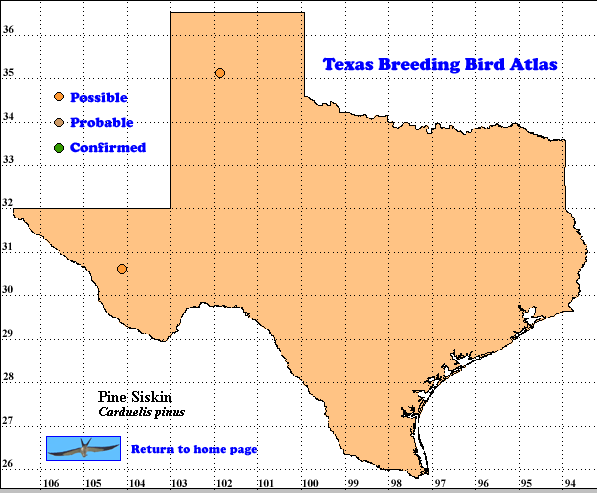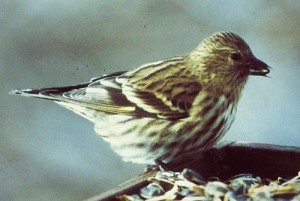The Pine Siskin, recognized most easily by its characteristic “slurp” call, is a widespread breeder, usually in coniferous and mixed coniferous-deciduous woodlands. Its diet includes many small seeds from plants such as composites and grasses, and trees such as alder and birch, as well as tender tree buds and stems and small insects and spiders. Siskins are opportunistic feeders and breeders, thus their distribution varies from year to year. This helps to explain the wide variations in winter distribution i Texas and occasional breeding records in the state (Dawson 1997).
DISTRIBUTION. During the 1987-1992 field work for the TBBA project, atlasers found possible Pine Siskin breeding in the Davis Mountains of Trans-Pecos Texas and in the northern Panhandle.Oberholser (1974) indicates breeding has occurred in the Guadalupe and Dais mountains and Lockwood and Freeman (2004) report a few breeding records for the state.
Elsewhere in North America Pine Siskin breeds from Alaska across Canada to Labrador, Newfoundland and Nova Scotia south in the mountains of the west to northern Baja California and mainland Mexico. In the east the species breeds regularly south to the northern parts of Minnesota, Wisconsin, Michigan and New England. In some years Pine Siskin may breed south to Kansas, Missouri, Illinois, Indian, Ohio, Pennsylvania, New York, southern New England and the southern Appalachian Mountains. The species winters irregularly as far south as the Isthmus of Tehuantepec. Migrants move south and/or to lower elevations. Numbers of wintering populations in any area nay vary widely from year to year (Dawson 1997, Lockwood and Freeman 2004).
SEASONAL OCCURRENCE. Migrating Pine Siskins arrive in Texas in late September (occasionally as early as August) and depart by late April with a few lingering to late May or even June. Most of the few breeding records for Texas are from late May and early June (Oberholser 1974, Lockwood and Freeman 2004).
BREEDING HABITAT. Most breeding occurs in open coniferous woodland. The nest is usually built 3-12 m (10-40 ft) above ground on a horizontal limb, well out from the trunk and concealed in foliage. The flat saucer of twigs, grasses, moss, lichens, bark strips and rootlets is large for the size of the bird. The nest, built by the female, is lined with rootlets, moss, fur and feathers. The outside diameter is 10 cm (4 in), height 4 cm (1.5 in) and inside diameter 5 cm (2 in).
The female usually lays 3-4 (range 2-5) smooth, pale greenish blue eggs, which she incubates for 13 days. The young birds leave the nest on day 13 after hatching. Brood parasitism by Brown-headed Cowbird (Molothrus ater) varies geographically, apparently infrequent in northern coniferous forests (Oberholser 1974, Harrison 1979, Dawson 1997).
STATUS. Lockwood and Freeman (2004). consider Pine Siskin to be a common to abundant migrant and winter visitor in the northern two-thirds of Texas and rare further south. Abundance is locally very irregular from year to year, especially in the southern parts of the state. The Breeding Bird Survey does not sample Pine Siskin in Texas, but data from 860 routes in the United States and Canada produce a statistically significant population trend of -2.3% per year for the period 1966-2004 (Sauer et al. 2004).
In this unpredictable species, breeding will probably continue irregularly, especially in the Guadalupe and Davis mountains at the end of the winter residency of migrants. Birdwatchers should be on the lookout there for nesting activity. Text by Robert C. Tweit (2005)
 Literature cited.
Literature cited.
Dawson, W. R. 1997. Pine Siskin (Carduelis pinus). InThe birds of North America, No. 280 (A. Poole and F. Gill, eds.). The Birds of North America, Inc., Philadelphia, PA.
Harrison, H. H. 1979. A field guide to western birds’ nests. Houghton Mifflin, Boston, MA.
Lockwood, M. W. and B. Freeman. 2004. The TOS handbook of Texas birds. Texas A&M University Press, College Station.
Oberholser, H. C. 1974. The bird life of Texas, Vol. 2. University of Texas Press, Austin.
Sauer, J. R., J. E. Hines, and J. Fallon. 2005. The North American Breeding Bird Survey, results and analysis 1966-2004. Version 2005.1. USGS Patuxent Wildlife Research Center, Laurel MD (Web site, http://www.mbr-pwrc.usgs.gov/bbs).
